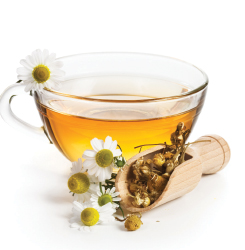
Jun J. Mao, MD, MSCE

Jyothirmai Gubili, MS
The ASCO Post’s Integrative Oncology series is intended to facilitate the availability of evidence-based information on integrative and complementary therapies commonly used by patients with cancer. In this installment, Jun J. Mao, MD, MSCE, and Jyothirmai Gubili, MS, focus attention on chamomile and its long medicinal history as well as review clinical data on its role in decreasing symptoms of anxiety.

Scientific Names: Matricaria recutita, Chamomilla recutita, Matricaria chamomilla
Overview
Chamomile is an aromatic annual herb native to Europe, North Africa, and Northwest Asia. It has a long medicinal history and was used to treat stomach and menstrual disorders, insomnia, rheumatic pain, hemorrhoids, and for wound healing. Current uses include employing chamomile-derived essential oils in cosmetics and aromatherapy. Tea brewed from the dried flower heads is also immensely popular for its calming effects and as a sleep aid.
Investigations conducted over the past few decades indicate that chamomile may be effective against generalized anxiety disorder and insomnia. It also demonstrated wound-healing properties and is being considered as a treatment for chemotherapy-induced mucositis.
The Science
In preclinical studies, chamomile demonstrated anti-inflammatory,1 antihyperglycemic,2 antigenotoxic,3 wound-healing,4 and anticancer5 effects. The dried flowers contain terpenoids and flavonoids, which contribute to the herb’s medicinal effects.
Preliminary clinical data suggest modest benefits of oral chamomile in improving chronic insomnia6 and of chamomile tea in improving glycemic control in patients with diabetes.7 Noteworthy are studies that show its effectiveness against generalized anxiety disorder. In a randomized controlled trial involving 57 patients with mild to moderate generalized anxiety disorder, an oral chamomile extract (1,100 mg/d for 8 weeks) was well tolerated and demonstrated modest anxiolytic activity compared with placebo.8 Secondary analyses of these data showed clinically significant antidepressant activity9 and shed light on how favorable self-generated patient expectancies for treatments may lead to greater improvements and fewer adverse events.10
Further investigations found chamomile (at 1,500 mg/d for 8 weeks) to be effective against moderate to severe generalized anxiety disorder as well in a trial of 179 patients.11 When responders to this treatment were randomized to 26 weeks of continued therapy (1,500 mg of chamomile per day) or placebo, significant generalized anxiety disorder reductions were noted in the experimental group.12 Overall data suggest that long-term use of chamomile is safe and may be effective for alleviating moderate to severe generalized anxiety disorder symptoms. In addition, a recent study reported that chamomile may improve the cortisol slope, a biologic marker of chronic stress, in people with chronic anxiety.13
In other trials, application of a chamomile compress was found to be effective in promoting healing of peristomal skin lesions in patients after colostomy.14 And chamomile tea intake was associated with a reduced risk of thyroid cancer in an observational study.15 However, definitive data are lacking to determine the efficacy of a mouthwash containing chamomile for alleviating mucositis associated with fluorouracil (5-FU).16-18
Proposed mechanisms underlying the anxiolytic activity of chamomile include modulation of γ-amino butyric acid (GABA), noradrenaline, dopamine, and serotonin neurotransmission19 or that of hypothalamic-pituitary-adrenocortical axis function20 by its flavonoid constituents. Other compounds including apigenin were also reported to bind to benzodiazepine receptors, decreasing GABA-activated effects.21
The anti-inflammatory effects of the herb occur via inhibition of COX-2 enzyme, which results in release of lipopolysaccharide-induced prostaglandin E2 in vitro.1 In addition, apigenin showed strong chemopreventive effects and inhibited the progression and metastasis of choriocarcinoma cells by regulating the phosphatidylinositol 3-kinase/protein kinase B and extracellular signal-regulated kinase/mitogen-activated protein kinase pathways.22 And concurrent use of bisabolol oxide A, another constituent of chamomile, was shown to lower the dose of 5-FU required to inhibit the growth of human leukemia cells.23
Adverse Reactions: Case Reports
For those individuals with allergy to ragweed, exposure to raw chamomile can cause asthma, contact dermatitis, and anaphylaxis.24-26
Premature constriction of ductus arteriosus was observed in a fetus after the mother consumed chamomile tea during pregnancy.27
Severe anaphylaxis with generalized urticaria, angioedema, and severe dyspnea was reported in a 38-year-old man 1 hour after ingestion of chamomile tea. Symptoms improved after treatment with an intravenous antihistamine.28
A 70-year-old woman suffered multiple internal hemorrhages after simultaneous use of chamomile products and warfarin.29
Inhaling dried chamomile flowers resulted in a case of occupational allergic rhinoconjunctivitis.30
Increased lactogenesis and breast tension were reported in a lactating woman a few hours after consuming chamomile.31
Herb-Drug Interactions
Anticoagulants/Antiplatelets: Chamomile may have additive effects due to its coumarin content.29
Cytochrome P450 Substrates: Chamomile has been shown to inhibit CYP1A2, CYP2C9, CYP2D6, and CYP3A4, and it may increase the intracellular concentration of drugs metabolized by these enzymes. The clinical relevance is yet to be determined.32
Cyclosporine: Concurrent use of cyclosporine and chamomile may result in increased serum levels of cyclosporine.33
Summary
Chamomile has a long historical use for its calming effects. Recent clinical data suggest that it is well tolerated and may decrease chronic to moderate and moderate to severe anxiety symptoms. As anxiety is a common symptom for many cancer survivors, this herb can be considered for those who prefer natural products over conventional medications. However, it should be avoided in individuals with allergy to ragweed. Appropriate diagnoses and continued management are needed to ensure optimal therapeutic effects and minimize side effects. ■
DISCLOSURE: Dr. Mao and Ms. Gubili reported no conflicts of interest.
Dr. Mao is Laurance S. Rockefeller Chair in Integrative Medicine and Chief, Integrative Medicine Service, Memorial Sloan Kettering Cancer Center, New York. Ms. Gubili is Editor, Integrative Medicine, Memorial Sloan Kettering Cancer Center, New York.
REFERENCES
1. Srivastava JK, Pandey M, Gupta S: Chamomile, a novel and selective COX-2 inhibitor with anti-inflammatory activity. Life Sci 85:663-669, 2009.
2. Cemek M, Kaga S, Simsek N, et al: Antihyperglycemic and antioxidative potential of Matricaria chamomilla L. in streptozotocin-induced diabetic rats. J Nat Med 62:284-293, 2008.
3. Hernández-Ceruelos A, Madrigal-Bujaidar E, de la Cruz C: Inhibitory effect of chamomile essential oil on the sister chromatid exchanges induced by daunorubicin and methyl methanesulfonate in mouse bone marrow. Toxicol Lett 135:103-110, 2002.
4. Reddy KK, Grossman L, Rogers GS: Common complementary and alternative therapies with potential use in dermatologic surgery: Risks and benefits. J Am Acad Dermatol 68:e127-e135, 2013.
5. Srivastava JK, Gupta S: Antiproliferative and apoptotic effects of chamomile extract in various human cancer cells. J Agric Food Chem 55:9470-9478, 2007.
6. Zick SM, Wright BD, Sen A, et al: Preliminary examination of the efficacy and safety of a standardized chamomile extract for chronic primary insomnia: A randomized placebo-controlled pilot study. BMC Complement Altern Med 11:78, 2011.
7. Rafraf M, Zemestani M, Asghari-Jafarabadi M: Effectiveness of chamomile tea on glycemic control and serum lipid profile in patients with type 2 diabetes. J Endocrinol Invest 38:163-170, 2015.
8. Amsterdam JD, Li Y, Soeller I, et al: A randomized, double-blind, placebo-controlled trial of oral Matricaria recutita (chamomile) extract therapy for generalized anxiety disorder. J Clin Psychopharmacol 29:378-382, 2009.
9. Amsterdam JD, Shults J, Soeller I, et al: Chamomile (Matricaria recutita) may provide antidepressant activity in anxious, depressed humans: An exploratory study. Altern Ther Health Med 18:44-49, 2012.
10. Keefe JR, Amsterdam J, Li QS, et al: Specific expectancies are associated with symptomatic outcomes and side effect burden in a trial of chamomile extract for generalized anxiety disorder. J Psychiatr Res 84:90-97, 2017.
11. Keefe JR, Mao JJ, Soeller I, et al: Short-term open-label chamomile (Matricaria chamomilla L.) therapy of moderate to severe generalized anxiety disorder. Phytomedicine 23:1699-1705, 2016.
12. Mao JJ, Xie SX, Keefe JR, et al: Long-term chamomile (Matricaria chamomilla L.) treatment for generalized anxiety disorder: A randomized clinical trial. Phytomedicine 23:1735-1742, 2016.
13. Keefe JR, Guo W, Li QS, et al: An exploratory study of salivary cortisol changes during chamomile extract therapy of moderate to severe generalized anxiety disorder. J Psychiatr Res 96:189-195, 2018.
14. Charousaei F, Dabirian A, Mojab F: Using chamomile solution or a 1% topical hydrocortisone ointment in the management of peristomal skin lesions in colostomy patients: Results of a controlled clinical study. Ostomy Wound Manage 57:28-36, 2011.
15. Riza E, Linos A, Petralias A, et al: The effect of Greek herbal tea consumption on thyroid cancer: A case-control study. Eur J Public Health 25:1001-1005, 2015.
16. Fidler P, Loprinzi CL, O’Fallon JR, et al: Prospective evaluation of a chamomile mouthwash for prevention of 5-FU-induced oral mucositis. Cancer 77:522-525, 1996.
17. Carl W, Emrich LS: Management of oral mucositis during local radiation and systemic chemotherapy: A study of 98 patients. J Prosthet Dent 66:361-369, 1991.
18. Dos Reis PE, Ciol MA, de Melo NS, et al: Chamomile infusion cryotherapy to prevent oral mucositis induced by chemotherapy: A pilot study. Support Care Cancer 24:4393-4398, 2016.
19. Marder M, Paladini AC: GABA(A)-receptor ligands of flavonoid structure. Curr Top Med Chem 2:853-867, 2002.
20. Reis LS, Pardo PE, Oba E, et al: Matricaria chamomilla CH12 decreases handling stress in Nelore calves. J Vet Sci 7:189-192, 2006.
21. Losi G, Puia G, Garzon G, et al: Apigenin modulates GABAergic and glutamatergic transmission in cultured cortical neurons. Eur J Pharmacol 502:41-46, 2004.
22. Lim W, Park S, Bazer FW, et al: Apigenin reduces survival of choriocarcinoma cells by inducing apoptosis via the PI3K/AKT and ERK1/2 MAPK pathways. J Cell Physiol 231:2690-2699, 2016.
23. Ogata-Ikeda I, Seo H, Kawanai T, et al: Cytotoxic action of bisabololoxide A of German chamomile on human leukemia K562 cells in combination with 5-fluorouracil. Phytomedicine 18:362-365, 2011.
24. Vandenplas O, Pirson F, D’Alpaos V, et al: Occupational asthma caused by chamomile. Allergy 63:1090-1092, 2008.
25. Jacob SE, Hsu JW: Reactions to Aquaphor: Is bisabolol the culprit? Pediatr Dermatol 27:103-104, 2010.
26. Anzai A, Vázquez Herrera NE, Tosti A: Airborne allergic contact dermatitis caused by chamomile tea. Contact Dermatitis 72:254-255, 2015.
27. Sridharan S, Archer N, Manning N: Premature constriction of the fetal ductus arteriosus following the maternal consumption of camomile herbal tea. Ultrasound Obstet Gynecol 34:358-359, 2009.
28. Andres C, Chen WC, Ollert M, et al: Anaphylactic reaction to camomile tea. Allergol Int 58:135-136, 2009.
29. Segal R, Pilote L: Warfarin interaction with Matricaria chamomilla. CMAJ 174:1281-1282, 2006.
30. Benito P, Rodríguez-Perez R, García F, et al: Occupational allergic rhinoconjunctivitis induced by Matricaria chamomilla with tolerance of chamomile tea. J Investig Allergol Clin Immunol 24:369-370, 2014.
31. Silva FV, Dias F, Costa G, et al: Chamomile reveals to be a potent galactogogue: The unexpected effect. J Matern Fetal Neonatal Med 31:116-118, 2018.
32. Ganzera M, Schneider P, Stuppner H: Inhibitory effects of the essential oil of chamomile (Matricaria recutita L.) and its major constituents on human cytochrome P450 enzymes. Life Sci 78:856-861, 2006.
33. Colombo D, Lunardon L, Bellia G: Cyclosporine and herbal supplement interactions. J Toxicol 2014:145325, 2014.

